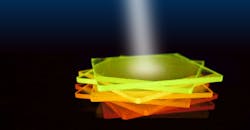Photoluminescence-based sensor aids light source meteorology, anti-counterfeit measures
In effort to better identify wavelengths of light, physics and chemistry researchers are moving beyond external spectrometers by developing a compact, organic thin-film sensor that achieves a spectral resolution of less than a nanometer (see video).
The technology was developed by a team at the Institute for Applied Physics, the Dresden Integrated Center for Applied Physics and Photonic Materials, and the Institute of Physical Chemistry (all at Technische Universität Dresden, Germany), and is based on a photoluminescence experiment. An active film is excited by light, which allows the researchers to measure its photoluminescence response.
The active film is just 20 to 40 µm thick, comprising two luminescent material species. One is a long-lived triplet emitter, which excites at a range of 10 ms to 1 s, and comes from a room-temperature phosphor. The other is a short-lived singlet emitter, which produces a photoluminescence response in nanoseconds.
“Triplets and singlets are two different spin states of excited states in semiconductors that exhibit a huge difference in lifetime,” says Anton Kirch, a researcher in the Institute of Applied Physics. Together, “the two species have a lifetime difference of about 7 orders of magnitude, and different absorption spectra.”
This allows researchers to selectively excite either the long- or short-lived emitter by tuning the excitation wavelength. Exciting the long-lived species produces a prominent afterglow in the thin film; exciting the short-lived species does not. By measuring the afterglow’s intensity, which is done via a simple silicon photodetector or an organic photodetector, the team can determine the excitation wavelength that was used as well as the wavelength fluctuations and, ultimately, achieve wavelength-selective technology (see Fig. 1).
“This relation can be used to determine wavelength fluctuations of light sources or to identify marker luminescent materials,” Kirch says, citing his team’s study published in Advanced Materials, in which they demonstrated this for laser wavelength tracking and identifying LED-spectrum shifts. “When excited, the materials show a certain photoluminescence emission spectrum that induces a unique response in our sensor (see Fig. 2).”
This work, Kirch notes, allows the researchers to transfer a fundamental property of some organic materials to show long-lived luminescence (or phosphorescence) into a proof-of-concept optoelectronics application. The team is moving toward commercializing the technology to create a low-cost, miniaturized system for simple wavelength meteorology tasks.
“Our development is a new application scenario of organic luminescent (light-sensitive) materials,” he says.
Their new sensor technology could someday be used for counterfeit protection—quickly checking for security features in banknotes and other documents without the need for expensive laboratory technology that tends to be large and bulky—or in organic and ideally environmentally friendly semiconductor devices and systems.
About the Author
Justine Murphy
Multimedia Director, Digital Infrastructure
Justine Murphy is the multimedia director for Endeavor Business Media's Digital Infrastructure Group. She is a multiple award-winning writer and editor with more 20 years of experience in newspaper publishing as well as public relations, marketing, and communications. For nearly 10 years, she has covered all facets of the optics and photonics industry as an editor, writer, web news anchor, and podcast host for an internationally reaching magazine publishing company. Her work has earned accolades from the New England Press Association as well as the SIIA/Jesse H. Neal Awards. She received a B.A. from the Massachusetts College of Liberal Arts.

